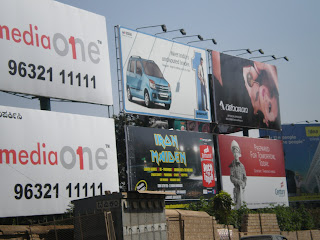 Longer discussion about slums and Slumdog Millionaire will come at some point, but I want to make a few minor points and show some shots. We are working on some more academic work on slums (how they develop, sustain themselves, and rarely disappear), so I have visited some "slum upgradation" projects. I'm hesitant to take pictures in lots of places, but there are a few here.
Longer discussion about slums and Slumdog Millionaire will come at some point, but I want to make a few minor points and show some shots. We are working on some more academic work on slums (how they develop, sustain themselves, and rarely disappear), so I have visited some "slum upgradation" projects. I'm hesitant to take pictures in lots of places, but there are a few here.Defining exactly what a slum is and isn't is quite hard. The definitions used, even in official documents around India, are inconsistent. No public services is a start, but then are entire villages where basic needs are met slums? Probably not. Is it many dwellings or must there be many? Here are some possible contenders, but each would fall short on some defs and qualify under others.
 One dwelling, with a family living under a tarp.
One dwelling, with a family living under a tarp. Several dwellings, on the side of Bellary Road near the Agricultural University. These are relatively new. Below, a lane of "temporary" houses where the construction workers for the buildings in the background are living. This is down the street from us.
Several dwellings, on the side of Bellary Road near the Agricultural University. These are relatively new. Below, a lane of "temporary" houses where the construction workers for the buildings in the background are living. This is down the street from us. Now onto "upgradation". Below is a shot of a government-sponsored slum upgradation scheme. More discussion on it at some future point.
Now onto "upgradation". Below is a shot of a government-sponsored slum upgradation scheme. More discussion on it at some future point. Slightly to the left.
Slightly to the left. Note the stove outside. Now, when I think of "slumdogs" I think of the dogs that inevitably are living around slums.
Note the stove outside. Now, when I think of "slumdogs" I think of the dogs that inevitably are living around slums. Lots of them.
Lots of them. Men hanging around in the middle of day is something you find.
Men hanging around in the middle of day is something you find. Note the water tanks. There is supposed to be running water in this project, but the pipes are all clogged up. Little markets and stores that sell essentials like tea, coffee, sugar, and the like in tiny packets that sell for less than 5 rupees ($0.20 in the US) are found throughout the lanes. You can also see that this project's houses have electric meters. Even the slum they moved from had metered electricity, even though the houses would get washed out when it rained (it was on the top of a hill).
Note the water tanks. There is supposed to be running water in this project, but the pipes are all clogged up. Little markets and stores that sell essentials like tea, coffee, sugar, and the like in tiny packets that sell for less than 5 rupees ($0.20 in the US) are found throughout the lanes. You can also see that this project's houses have electric meters. Even the slum they moved from had metered electricity, even though the houses would get washed out when it rained (it was on the top of a hill).
 Successfull "upgradation" -- clean, well tended, and if folks have time and money to decorate with rangolis in front of their doors, they have moved up somewhat. So much more to say, but I will post this for now, as I have to do some work.
Successfull "upgradation" -- clean, well tended, and if folks have time and money to decorate with rangolis in front of their doors, they have moved up somewhat. So much more to say, but I will post this for now, as I have to do some work.

























